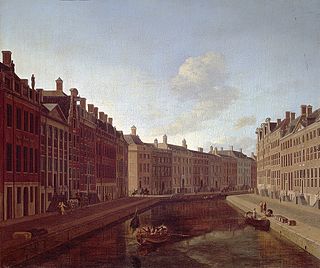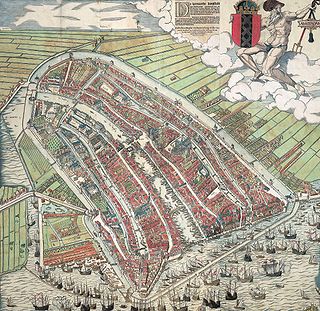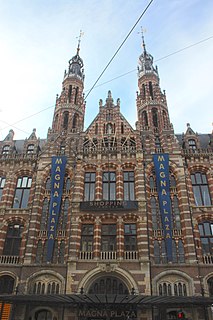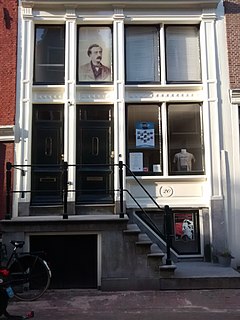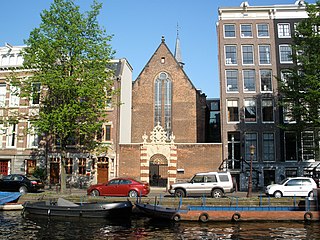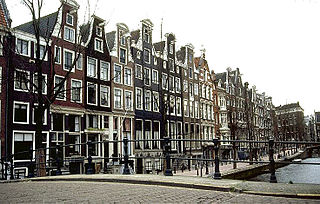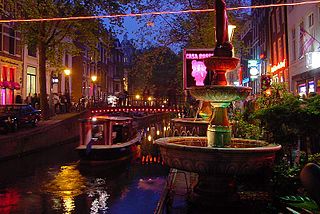

The Huis aan de Drie Grachten or Huis op de Drie Grachten ("House on Three Canals") is a 17th-century canal house in Amsterdam, at the southeastern end of the Wallen district. The name is a reference to the fact that the building faces three different Amsterdam canals. The south facade faces Grimburgwal, the west facade faces Oudezijds Voorburgwal and the east facade faces Oudezijds Achterburgwal. The address is Oudezijds Voorburgwal 249.

A canal house is a house overseeing a canal. These houses are often slim, high and deep. Because of the danger of flooding the front door is sometimes higher up and only accessible via stairs. The floor of the main storey lies about seven to nine steps above street level. Many stoops disappeared in the 19th century when entrances were moved to the basement.
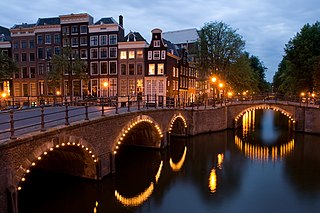
Amsterdam is the capital and most populous city of the Netherlands, with a population of 866,737, 1,380,872 in the urban area, and 2,410,960 in the metropolitan area. Amsterdam is in the province of North Holland.

De Wallen or De Walletjes is the largest and best known red-light district in Amsterdam. It consists of a network of alleys containing approximately three hundred one-room cabins rented by prostitutes who offer their sexual services from behind a window or glass door, typically illuminated with red lights and blacklight. Window prostitution is the most visible and typical kind of red-light district sex work in Amsterdam.
The Huis aan de Drie Grachten is a double house in Dutch Renaissance style. A stepped gable crowns each of the three facades. The current structure dates to around 1610, although archeological study has shown that the oldest elements of the house date to the second quartile of the 16th century. The building has rijksmonument (national monument) status. [1] [2]

The Renaissance in the Low Countries was a cultural period in the Northern Renaissance that took place in around the 16th century in the Low Countries.
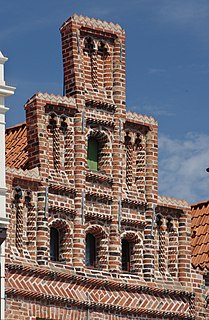
A crow-stepped gable, stepped gable, or corbie step is a stairstep type of design at the top of the triangular gable-end of a building. The top of the parapet wall projects above the roofline and the top of the brick or stone wall is stacked in a step pattern above the roof as a decoration and as a convenient way to finish the brick courses.

A rijksmonument is a national heritage site of the Netherlands, listed by the agency Rijksdienst voor het Cultureel Erfgoed (RCE) acting for the Dutch Ministry of Education, Culture and Science.
In 1909, the building underwent large-scale renovations under the supervision of the architect Jan de Meijer. He aimed to restore the building to its original 17th-century state, basing himself on a contemporary painting of the house by Gerrit Berckheyde which is now in the collection of the Amsterdam Museum. During the renovations, the building was given new stepped gables, kruiskozijnen (windows that are divided into four smaller windows by crossbeams), and a sandstone entrance gate. These replaced the original elements which had been demolished in the 18th century. The renovation also stripped the interior of the house of elements which had been added over the centuries. In 2005, the building underwent a second renovation. [1] [2]

Gerrit Adriaenszoon Berckheyde was a Dutch Golden Age painter, active in Haarlem, Amsterdam, and The Hague, who is best known today for his cityscapes.
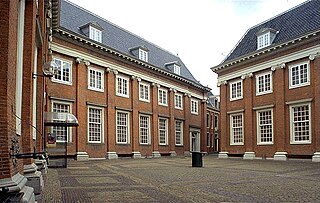
The Amsterdam Museum, until 2011 called the Amsterdams Historisch Museum, is a museum about the history of Amsterdam. Since 1975, it is located in the old city orphanage between Kalverstraat and Nieuwezijds Voorburgwal.
There are two large 17th-century mantelplaces within the house. However, it is not known whether these were added during the 1909 renovations, or whether these are original elements of the house. [2]

The fireplace mantel or mantelpiece, also known as a chimneypiece, originated in medieval times as a hood that projected over a fire grate to catch the smoke. The term has evolved to include the decorative framework around the fireplace, and can include elaborate designs extending to the ceiling. Mantelpiece is now the general term for the jambs, mantel shelf, and external accessories of a fireplace. For many centuries, the chimneypiece was the most ornamental and most artistic feature of a room, but as fireplaces have become smaller, and modern methods of heating have been introduced, its artistic as well as its practical significance has lessened.
August Aimé Balkema opened a bookstore in the building in 1936. During the Second World War, the bookstore was used to clandestinely print and publish works of poetry and other literature. A hidden compartment over one of the mantelpieces was uncovered during the renovations in 2005. This compartment was found to contain an archive of wartime documents, including manuscripts and correspondence. The compartment may also have served as a hiding place for (Jewish) onderduikers (people hiding from the Germans). [3] [4]
August Aimé (Guus) Balkema, or A.A. Balkema, was a Dutch book trader and publisher active in Amsterdam and South Africa. He played a prominent role in the South African publishing world and was included in They shaped our century (1999), a list of the 100 most influential people in South Africa in the 20th century.
The building remained in use as a bookstore until 2002. [4] The publishing house Uitgeverij Huis aan de Drie Grachten held office in the building for decades. The publisher focused mainly on literary and linguistic studies. Over Multatuli, a journal dedicated to the Dutch writer Multatuli, was also published here from 1978. [5]

Eduard Douwes Dekker, better known by his pen name Multatuli, was a Dutch writer best known for his satirical novel Max Havelaar (1860), which denounced the abuses of colonialism in the Dutch East Indies. He is considered one of the Netherlands' greatest authors.
